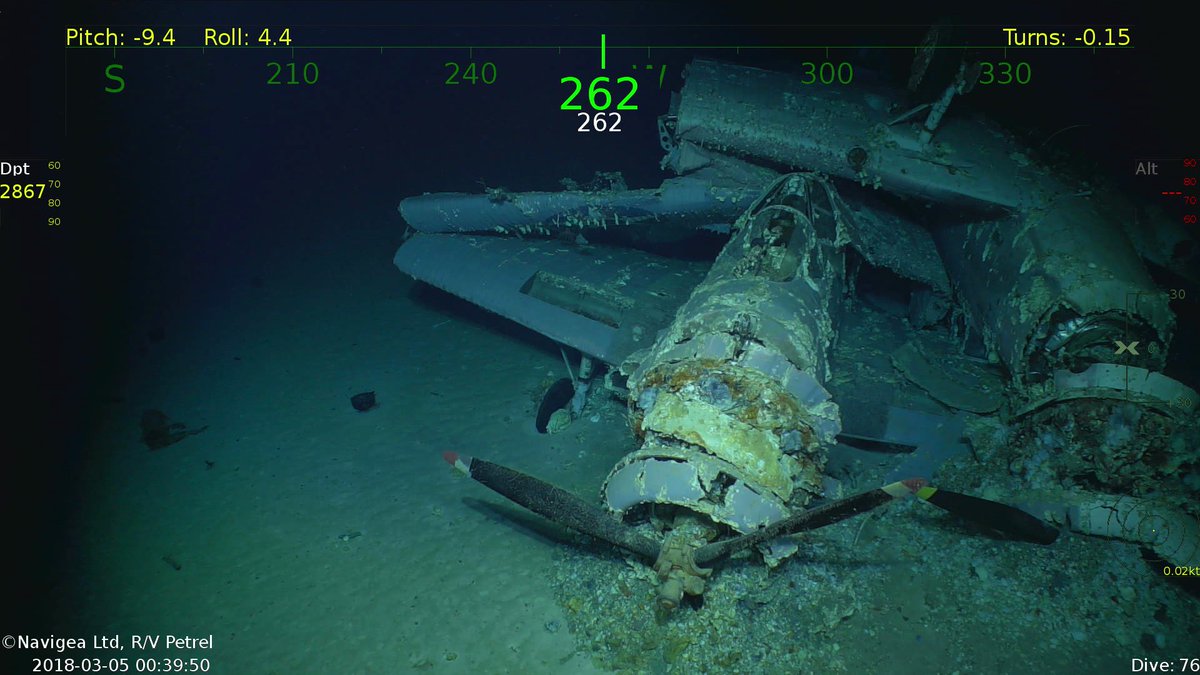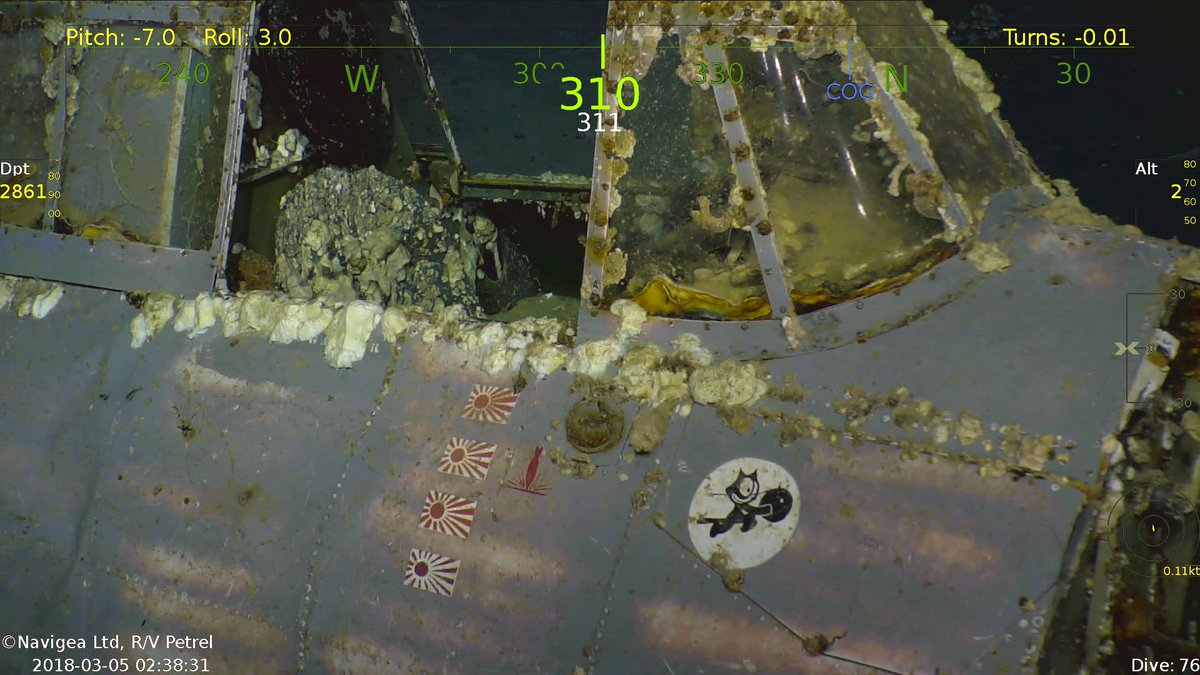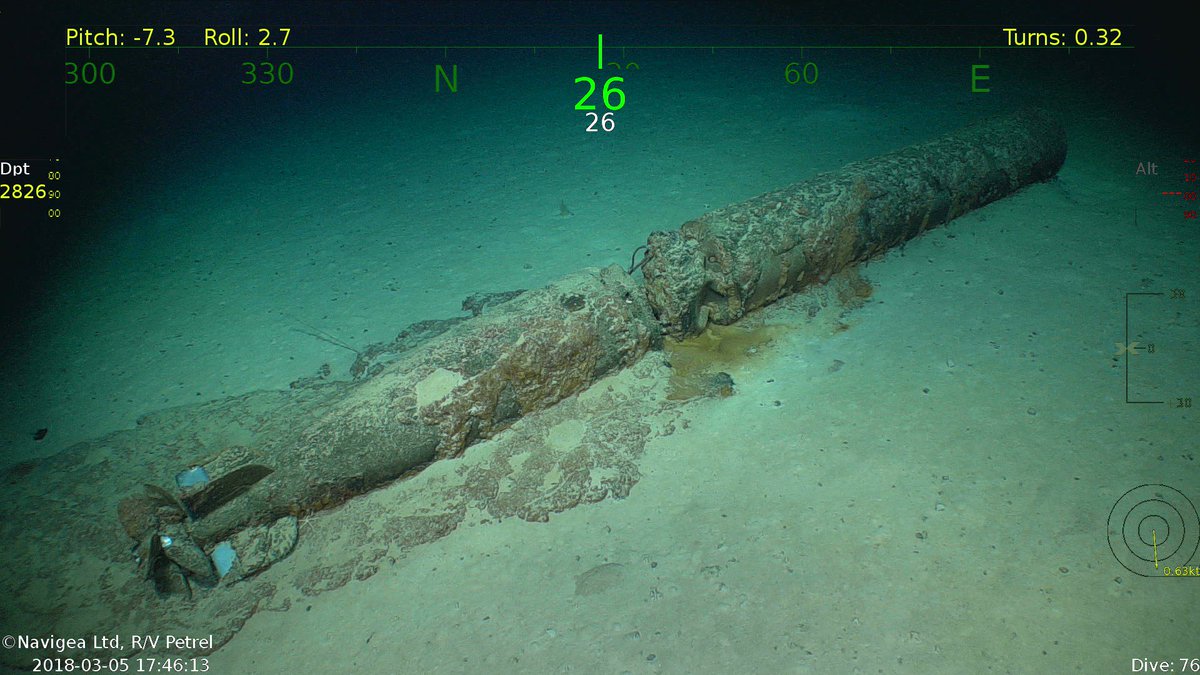The RV Petrel team, sponsored by Paul G. Allen of Microsoft, has continued their work in finding and documenting the lost ships of the Second World War. Yesterday, 3-4-2018, they took video footage of the wreck of the USS Lexington, CV-2.
This is a section of Lexington's general plans from 1941. The AA guns in question are the left two of the group of three on the top of the picture. I don't feel comfortable saying which gun this is, but it gives a general idea of where this gun is located.
This looks to be a 5''/25 Caliber gun, the first heavy AA gun the US expressly designed for the role. Lexington had twelve of them when she was sunk. Each gun would have around ten men to crew it.
0:24: The big one, the nameplate of Lexington.
This is right at the very end of the ship. The slanted area on the left is the very back end of the flight deck, the open hatch leads to what is listed as workrooms, a .50 caliber AA belting room, a radio compass booth, and some sound machinery. This area can be seen in the section of the General Plans above.

http://usnhistory.navylive.dodlive.mil/2018/03/09/modern-treasure-uss-lexington-reveals-rare-f4f-wildcats/
https://www.facebook.com/rvpetrel/
http://ethw.org/The_CXAM_Goes_to_War_-_Chapter_6_of_Radar_and_the_Fighter_Directors
https://text-message.blogs.archives.gov/2016/02/09/the-death-of-a-lady-the-uss-lexington-part-i-the-log/
There are just a few things of note shown in the video, but I felt that I couldn't leave this alone.
0:06: There were several 5'' AA guns located on the port stern quarter of Lexington. This is probably gun #10 or #12, since a fallen set of stairs can be seen in the background on the left side of the screen.
0:24: The big one, the nameplate of Lexington.
This is a view from the starboard side taken from the same plan. Here you can see the location of the nameplate, the hatch, and the staircase leading up from the hatch.
The nameplate itself. In the background below the plate, the two doors on the plan can be faintly seen. The struts on the right side are supports for a 3'' gun platform. The portholes can also be seen behind the nameplate. I believe that those are for the optical and instrument repair shop as can be seen on the plan.
Last of all, a staggeringly intact TBD Devastator torpedo bomber.
The lower photo is of Devastators aboard USS Enterprise, showing how the wings fold, and the distinctive shape of the canopy. The paint has remained incredibly intact for being on the floor of the ocean for more than 75 years. I've heard that there are more aircraft that have been documented, but I've not found photos of them yet.
The Lexington was lost at the Battle of the Coral Sea on May 8th, 1942. The majority of her crew were evacuated, but 216 men were still lost with the ship. This post might be updated depending on what new information on the ship's condition is released in the next few days.
UPDATE 3-6-2018
No more information on the ship's condition has come up yet, but a few more photos have been posted on paulallen.com.
There is no information on where this is, but this is a 1.1''/75 caliber AA gun, also known as the Chicago Piano. This was an inferior weapon to the later 20mm Oerlikon and 40mm Bofors guns, and was replaced fairly quickly in frontline service when possible.
Two more of Lexington's TBD Devastators resting atop each other. The far one has flipped over.
One of Lexington's F4F Wildcat fighters. It looks to be in rougher condition, but you can still clearly see the four Japanese flags denoting kill marks, and what looks like a bomb drawn right beside them. The emblem is that of then-VF-3, which fought throughout the Pacific war. On July 15th, 1943, the squadron was redesignated VF-6.
This is a depiction of what one of the Wildcats of Fighter Squadron 3 would have looked like in its day.
And a drawing of one of the TBD Devastators of Torpedo Squadron 2 as well.
According to paulallen.com, Lexington went down with 35 aircraft still aboard.
Update @ 1135
According to Paul Allen's Twitter, the RV Petrel has found 11 of the 35 aircraft lost with Lexington. The following photos are from that feed.
This looks to be another angle of the two TBD Devastators that can be seen above. Their landing gear can be clearly seen, as can the mostly intact paintwork. The engines all seem to have fallen from the planes, probably due to the saltwater of the ocean degrading the structure of the airframe.
This is an up-close look at the same Wildcat as is seen above, giving a good look at the kill markings and the squadron logo.
Last of all, something different, and something very interesting.
It looks to be a Mark 15 torpedo of the type used by American destroyers during the Second World War. The USS Phelps (DD-360) fired torpedoes like this to scuttle the Lexington after the ship was disabled by Japanese aircraft. I've read that there were as many as five, or as few as two torpedoes fired. But considering the issues with American torpedoes early in the war, it's probable that out of five fired, only two detonated. This could very well be one of the torpedoes that failed to detonate.
The ship-launched Mk 15 (22' 7'' long) was significantly longer than the air-dropped Mk 13 (15' 5'' long), which is why I think that this is a Mk 15.
Personally, I'm looking forward to more detail on the material condition of the ship. We've seen the stern with part of the flight deck, and few AA guns. Nothing on the rest of the flight deck, the superstructure and possible bomb damage, or the rest of the hull where two Japanese torpedo hits crippled Lexington.
Update 3-7-2018
The RV Petrel's page on Facebook posted this mosaic of sonar images of the wreck of Lexington. Up is north, the torpedo is to the south. The hull seems to have broken into three major pieces, of which the stern seems to be upright. I have not seen any photos of the other sections of the hull, but it might be possible for images to be taken from inside the ship considering how broken up it is.
Update @ 2200
Another photo that I neglected to add before.
This is a shield for an AA gun, I believe that this is for one of the 5''/25 caliber AA guns like can be seen in one of the above photos. It has information for setting the gun, and the shell fuzes for targeting both dive bombers and torpedo bombers.
Update 3-9-2018
The RV Petrel page on Facebook posted some updates, and a correction. The high-resolution sonar image was labeled incorrectly.
The main portion of the hull is much closer than it was labeled. There still doesn't seem to be any images of the bow or the rest of the hull.
They also added a longer video, which gives some more details.
This is the same 5'' AA gun that is shown above. Just visible on the plans is a small notch in the underside of the flight deck, behind the gun. As can be seen, it's a semicircular one, which is what Gun #10 seemed to have based on the plans. On the other hand, it doesn't look like there is another gun farther astern of this one. But from some photos that I've looked at, Gun #12 doesn't seem to have had a gun shield like the two that can be seen here. Though it might be the detached one that can be seen up-post.
There just aren't many good photos of the stern 5'' mounts of Lexington, and until we get a wider angle image of the area, we can't be sure.
This is the stern of the hull below the nameplate. The supports for a 3'' gun platform can be seen, and below that, a section of the hull that's been ruptured somehow. That area looks to be around the middle half deck or the second deck. Things in that area were the ship's laundry and some crew berthing.
There was also some video of the first TBD that was seen.
This shows the same decay around the engine that can be seen in all of the other aircraft.
I'm not a marine biologist, but I would like to know about the little mushroom things that are growing off the fuselage. In fact, it would be interesting to see a list of the marine life that seems to like growing on old wrecks like this one.
3-10-2018 - Title Changed to Reflect the Real Nature of this Post.
The RV Petrel Facebook page posted several photos of the main portion of the hull.
Here is where my copy of the plans falls short. My version is from 1936, with the last updates in 1941. In 1942, the Lexington was fitted with more AA guns, and the 8'' guns were removed.
According to the page, these two 1.1 inch guns are located just aft of the exhaust stack where the 8'' guns were. It was planned to install 5''/38 AA guns in turrets in the same place, but those were not installed before the Battle of the Coral Sea.

These two are mounts for quad 1.1" AA guns. The top photo should be aft of the funnel, and the bottom photo forward. The forward mount still has the gun in it, badly smashed, and some gunnery instructions painted on the splinter shield.
These are part of the 20mm gun battery added in the March 1942 refit outboard of the funnel. This can be seen in the photo below, just below the line of life rafts. The absent 8'' guns and the 1.1'' guns that are in their place can also be seen.
This is after the first torpedo hit, as she is down slightly by the bow.
There were also more 20mm guns added to the port side.
These are just below the level of the flight deck.
I think that these guns can be seen in this photo of Lexington just before the battle, though it's not of high enough resolution to be sure.
This is the breaking point towards the bow, in the area of frame 72. The wood of the flight deck can be seen, and it apparently just drops off to the seafloor. Lexington suffered a torpedo hit in the vicinity of Frame 72, which can be seen in the photo below of the port side.
It's worth pointing out what is in the area of Frame 72, which could explain the massive amounts of damage.
Frame 72 is just under the elevator well, and the area forward of that is a whole load of bombs and other ammunition storage. It's probable that the combination of battle damage, the scuttling, and the stresses of the sinking was enough to set off enough of the explosives stored there.
This is apparently one of the port-aft 5'' guns, just forward of the break in the hull. If so, this would mean that the two guns that we've seen in the stern would be numbers 10 and 12, and that this would be number 8.
These are the starboard-aft 5''/25 guns, which have detached and fallen away from the rest of the ship, leaving the deck vertical. The wood of the flight deck can be seen, and the guns seem to be aimed back over the flight deck. Because of how the piece has fallen, the guns might have been forced up relative to the flight deck. These guns can be seen in the photo of Lexington from the starboard side up above.
The 5'' guns are in the area of Frame 170, under the Main Driving Motor Room, about 1/4 from the right of the picture. There were many stores of ordnance in this area as well, including the 8'' shell and powder storage rooms, and what seems to be the storage area for torpedoes. The detonation of the torpedoes and other ammunition so deep in the hull would probably be enough to break up the ship. But without more detail on the condition of the split, we can't really tell more as of yet.
Also, the identity of the pilot of the Wildcat is now known. Lt. Noel Gayler was a member of VF-3 at the time, and during the battle, he was credited with two kills and a probable and landed aboard the damaged Lexington. He was unable to take off again and went over the side when the order to abandon ship was given.
His later career was immensely successful. He was awarded the Navy Cross three times, was given credit for five kills, acted as a test pilot, the commander of VF-12, the commanding officer of the USS Bairoko [CVE-115], the USS Greenwich Bay [AVP-41], and the USS Ranger [CV-61], the 6th director of the NSA, and the Commander in Chief United States Pacific Command (CINCPAC) before retiring from the Navy in 1976. He passed in 2011 at the age of 96.
3-11-2018
More photos, this time of the bow section. It is incredible how well the wooden flight deck has stood up to the conditions on the seafloor.
According to the description, this is the port side of the bow, but I think that this is incorrect based on the shape of the deck. This seems to be a chunk of the starboard bow, based on the openings in the front, and the life netting that can be seen hanging off the corner.
The openings in the ramp and its shape can be seen, as can the life netting. These nets could be folded so they stood upright, or laid down like they are shown in the drawing above. Also of note in this is the AA Gun Platform.
The 1.1'' AA gun can be seen, in what looks like the AA platform. It would seem that the 3'' AA guns that were originally there were replaced with the 1.1'' guns during a refit. In fact, all of them might have been replaced, as so far, there hasn't been any confirmation that there were any via photos.
Last of all, the side of the hull.
The opening for the starboard anchor is roughly in the center of the frame, down and to the right of it is what seems to be a hawsehole (a hole for mooring lines). It seems that the life netting that can be seen in the first photo of this update is also visible on the corner of the deck on the far right of the frame.
Below is a view of this area in the general plans, the life netting, and the openings for the anchor chain and mooring lines can also be seen. There doesn't seem to be much of the hull below the middle half deck in this area, and I'm not willing to speculate. But there wasn't anything especially volatile in that area of the ship.
Also, more of the shape of the AA platform can be seen. The gun closer to the prow is a 3'', and the two behind it are .50 caliber machine guns.
This lower-angle view from the bow, probably in 1939, gives an idea of what this area looked like while the ship was intact. As can be seen, it was swept out, which gives a distorted view of its shape now that it's detached and rotated.
3-12-2018
More photos of the stern.
This is from behind the flight deck looking forward towards the bow.
It does really seem like all of the 3'' AA guns were replaced with 1.1'' guns. This is the gun forward of the nameplate, which can just be seen under the line of portholes around the netting in the left half of the frame. It looks like there might still be the .50 caliber machine guns off to the right of the 1.1'' gun, or at least the mountings for other smaller weaponry like 20mm cannons.
This is another view of the end of the flight deck, off to the right is the area of the nameplate. All of these areas can be seen in the section of general plans below. This shows from the very end of the stern through to the 5'' AA guns, which is approximately where the stern broke off from the rest of the ship.
3-13-2018
The first photos of the bridge and mast have been released.
This is apparently the port side of the bridge, but I believe that this is incorrect. Based on the existing photos and the general plans, I believe that this is the starboard side of the pilothouse. To the right (above) is the remains of a 20' rangefinder, below is the armored conning tower.
This is more of the pilot house on the Navigating Bridge. The ladder close to the center can be seen in the first photo of the pilothouse. This whole assembly can be seen in the section of the plans below, showing most of the parts of the island that have been discovered.
This is much clearer, showing the top of the tripod mast and parts of the 8'' gun fire control platform.
This is another section of the mast, possibly the 5'' gun platform, which looks to have been built up more during the 1942 refit. As such, the general plan doesn't really have much of a resemblance to the photos. It seems to be a bit to narrow from what can be seen, but the rangefinder platforms might have been knocked off while the ship was sinking. The directors for the guns are also absent, so I'm really not sure what it is.
This looks to be the conning tower. The semi-cylindrical shape would be the actual conning tower, the beam with the lightning holes looks to be the same one that can be seen in the photo of the starboard side of the pilothouse. It looks to continue back a ways, though how far is unclear.
This would be the area of the Meteorological Platform or the Communications Platform.
Even after so long, what looks to be fire damage and scorching can be seen in this area.
Fires and large amounts of smoke can be clearly seen from this area. The aircraft on the stern probably are the very ones that have been photographed by the RV Petrel. Also of note is the smoke coming from around the stern port 5'' guns were, though this might be smoke coming from deeper inside the ship.
This shows the various levels of the island, from the Meteorological Platform at the bottom left, all the way up to the bottom of the 5'' control platform.
3-16-2018
I'll be making another post about the aircraft later, as there are so many photos that have been taken of them.
This is a mount for a 20mm cannon in the debris field.
The plaque reads:
U.S. NAVAL ORDINANCE PLANT
[Indecipherable]
20mm MOUNT
MK 4
SER. No 10040[?]
[Indecipherable]
1525 AS [?]
An Anchor
1942
This is a loaded magazine for a 20mm Oerlikon cannon. The back end of the shell can be seen, including the primer.
This is a Yarrow Three-Drum boiler. When in the ship, the large drum on the right would be above the other two water drums as can be seen in the photo below of a similar boiler design. Lexington had 16 of these boilers, able to produce enough power to drive the ship at more than 33 knots.
It is possible that this is from one of the forward boiler rooms, and fell out when the ship broke up around Frame 72. From what we've seen, the stern boiler rooms weren't in the area that broke up, so this is probably one of the forward boilers. Probably in B-1 or B-2 as can be seen below, in this section of the second platform.
A few other things in the debris field. In the top photo, there is a ladder and some sort of horn, or another type of brass instrument. The middle photo is of something on wheels with a tank, possibly an air compressor or a welder of some sort. The last photo shows a toolbox, but everything else I can't identify.
This is a section in front of the funnel but behind the rest of the superstructure. There isn't enough to get a better idea of where this is though.
This is part of the flight deck, but I'm not sure where exactly this is. I think that this is part of the bow since we've seen the entire stern, and the bow area has more changes in the profile of the flight deck.
Now the big one: A real, legitimate, bonafide CXAM-1 RADAR antenna.
This was the first production radar set installed on American ships. There were other one-off sets before, but this was the first one that was mass-produced. At the Coral Sea, Lexington detected incoming Japanese aircraft at about 68 miles away from the ship.
This antenna was attached to the front of the funnel, right at the top. This can be seen in the photos of Lexington at the Coral Sea above. Of note is that the antenna hasn't been censored out in these photos, which is interesting as many features like radar antennas were censored out during the war.
As far as I know, there are no surviving examples of the CXAM-1 anywhere. So this is probably the first time a CXAM-1 has been photographed in almost 70 years.
A more detailed look at the aircraft can be found here: The Wreck of the USS Lexington, Aircraft at the Bottom of the Coral Sea
5/13/2022
Updated broken links, photos, and made some grammatical corrections.
Sources:
http://www.hnsa.org/resources/manuals-documents/booklets-of-general-plans-online/
http://www.navsource.org/archives/02/02a.htm
http://www.navweaps.com/Weapons/WNUS_5-25_mk10.php
https://www.history.navy.mil/research/histories/ship-histories/danfs/l/lexington-cv-2-iv.html
https://www.paulallen.com/uss-lexington-wreck-located-rv-petrel/#pETAcjovhMt0f5co.01 - Dead link
Archived Link - https://web.archive.org/web/20190801100834/https://www.paulallen.com/uss-lexington-wreck-located-rv-petrel/
http://www.navweaps.com/Weapons/WNUS_1-1-75_mk1.php
http://www.wings-aviation.ch/22-USNavy-Carrier/Carrier-Basis-d.htm - Dead Link
Archived Link - https://web.archive.org/web/20180222101228/http://www.wings-aviation.ch:80/22-USNavy-Carrier/Carrier-Basis-d.htm
https://www.history.navy.mil/research/histories/ship-histories/danfs/p/phelps.html
http://destroyerhistory.org/goldplater/ussphelps/
http://www.navweaps.com/Weapons/WTUS_WWII.php
https://twitter.com/PaulGAllen
https://www.facebook.com/rvpetrel/?hc_ref=ARTNu8SyvhTjjvhMfJCUaqGYluyDyRxQpH-bmZbbjUos66r4h8HOGJi_c_47_p-pXr0&fref=nf
https://www.facebook.com/rvpetrel/
http://ethw.org/The_CXAM_Goes_to_War_-_Chapter_6_of_Radar_and_the_Fighter_Directors
https://text-message.blogs.archives.gov/2016/02/09/the-death-of-a-lady-the-uss-lexington-part-i-the-log/






_in_1942.jpg)
_leaving_San_Diego_on_14_October_1941_(80-G-416362).jpg)






















































.jpg/790px-Yarrow_boiler_tubes_(Rankin_Kennedy%2C_Modern_Engines%2C_Vol_VI).jpg)







Wow, it's amazing that the paint is in such good condition! What stunning photographs.
ReplyDelete